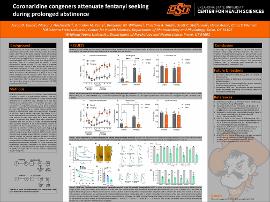| dc.contributor.author | Layne, Jacob D. | |
| dc.contributor.author | Hochstetler, Mason J. | |
| dc.contributor.author | Curry, Brandon M. | |
| dc.contributor.author | Williams, Benjamin M. | |
| dc.contributor.author | Small, Christina A. | |
| dc.contributor.author | Steffensen, Scott C. | |
| dc.contributor.author | Arias, Hugo | |
| dc.contributor.author | Werner, Craig T. | |
| dc.date.accessioned | 2023-11-02T20:46:39Z | |
| dc.date.available | 2023-11-02T20:46:39Z | |
| dc.date.issued | 2023-02-17 | |
| dc.identifier | ouhd_Layne_coronaridinecongenersattenuate_2023 | |
| dc.identifier.citation | Layne, J. D., Hochstetler, M. J., Curry, B. M., Williams, B. M., Small, C. A., Steffensen, S. C., Arias, H., and Werner, C. T. (2023, February 17). Coronaridine congeners attenuate fentanyl seeking during prolonged abstinence. Poster presented at Research Week, Oklahoma State University Center for Health Sciences, Tulsa, Ok. | |
| dc.identifier.uri | https://hdl.handle.net/11244/339910 | |
| dc.description.abstract | Background: The prevalence of opioid use disorder (OUD) has reached epidemic proportions with a record-breaking number of overdose deaths. Over 70% of the record-breaking number of overdose deaths are caused by synthetic opioids, including fentanyl. Fentanyl is commonly administered intravenously or by inhalation (smoking/vaping), which results in rapid drug bioavailability in the brain. There is a current need to identify a novel pharmacologic therapy to treat OUD, and there is increasing evidence to support the use of novel compounds referred to as coronaridine congeners to treat OUD and other psychiatric illnesses. In preclinical models, coronaridine congeners have been shown to decrease self-administration of drugs of abuse and induce antidepressant and anxiolytic effects. Here we used a preclinical fentanyl vapor self-administration model and fast-scan cyclic voltammetry (FSCV) to study the anti-addictive effects of two coronaridine congeners, 18-methoxycoronaridine (18-MC) and catharanthine (Cath). | |
| dc.description.abstract | Methods: C57BL/6J mice were trained to self-administer vaporized fentanyl (5 mg/mL) or vehicle in airtight operant chambers. Mice self-administered vapor for 1 hour per day for 10 days (sessions were conducted for 5 consecutive days, followed by 2 days off). Chambers were equipped with two nosepokes, one active and one inactive. A successful response in the active nosepoke resulted in a vapor delivery that coincided with the presentation of a cue light, followed by a 1-minute timeout period. Mice learned to self-administer vapor with 3-second vapor deliveries for the first 3 days of training, which was then reduced to 1.5-second vapor deliveries the remaining 7 days. After training, mice were returned to their home cages for a forced abstinence period. Cue-induced drug seeking tests were conducted on abstinence days (AD) 20 and 25. During cue-induced seeking tests, successful responses in the active nosepoke resulted in presentation of the drug-associated cue, but no vapor was delivered (i.e. extinction conditions). Cue-induced drug seeking tests were conducted using a crossover design where half of subjects received coronaridine treatment (18-MC or Cath), while the other half received vehicle (ddH2O), on AD20. On AD25, subjects received the opposite treatment compared to AD20. Mice were injected (i.p.) with either vehicle or coronaridine treatment 1 hour before seeking tests. To examine the molecular mechanism of coronaridine congeners, FSCV was conducted on dopaminergic pre-synaptic terminals in the nucleus accumbens (NAc) neurons to measure dopamine (DA) release in the presence of 18-MC and Cath with or without nicotinic acetylcholine receptor antagonists. | |
| dc.description.abstract | Results: We found that both 18-MC and Cath significantly reduced fentanylseeking during prolonged abstinence with no effect on mice that had previously self-administered vehicle. Furthermore, FSCV revealed that 18-MC and Cath significantly reduced DA release onto NAc neurons. | |
| dc.description.abstract | Conclusion: In this study, we report that both 18-MC and Cath decrease fentanyl seeking during prolonged abstinence. DA release is important for opioid-related behaviors, and we found that 18-MC and Cath reduce DA release in the NAc, a mechanism that may underlie the effect of coronaridine congeners on fentanyl seeking. Together, these results provide evidence that coronaridine congeners may be promising novel compounds for the pharmacotherapeutic treatment of OUD. | |
| dc.format | application/pdf | |
| dc.language | en_US | |
| dc.publisher | Oklahoma State University Center for Health Sciences | |
| dc.rights | The author(s) retain the copyright or have the right to deposit the item giving the Oklahoma State University Library a limited, non-exclusive right to share this material in its institutional repository. Contact Digital Resources and Discovery Services at lib-dls@okstate.edu or 405-744-9161 for the permission policy on the use, reproduction or distribution of this material. | |
| dc.title | Coronaridine congeners attenuate fentanyl seeking during prolonged abstinence | |
| osu.filename | ouhd_Layne_coronaridinecongenersattenuate_2023.pdf | |
| dc.type.genre | Presentation | |
| dc.type.material | Text | |
| dc.subject.keywords | opioid use disorder | |
| dc.subject.keywords | fentanyl | |
| dc.subject.keywords | self-administration | |
| dc.subject.keywords | relapse | |
| dc.subject.keywords | coronaridine congeners | |
